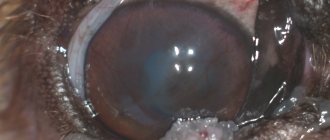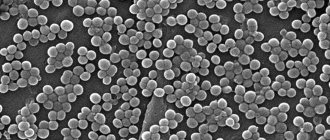- October 6, 2018
- Prostatitis
- Tatyana Andreeva
Dogs aged five years and older quite often suffer from inflammation of the prostate gland. Prostatitis in dogs is a serious disease that requires timely treatment. Symptoms of the pathology are often confused with cystitis, so only a veterinarian can make an accurate diagnosis and prescribe treatment. In this article we will take a closer look at the causes and methods of treating this insidious disease.
What it is
The prostate gland in dogs is an important organ. It is located in the area of the bladder neck and urogenital canal and plays an important role:
- produces ejaculate;
- blocks the opening of the bladder during ejaculation.
The organ has a lobed structure and a round shape. The animal’s body constantly produces ejaculate, which is excreted not only during the ejaculation process, but also with the animal’s urine.
Most often, prostatitis in dogs is of bacterial origin and is the result of inflammation in the prostate gland, urethra or bladder. These are the most common cases and occur more often than others. But sometimes the illness is a consequence of more serious diseases. One of these may be pyelonephritis.
In more than 80% of cases, prostatitis develops in uncastrated dogs aged 7-8 years. The older the animal, the higher the risk of pathology. The disease can be acute or chronic. The first form is more dangerous, as it often leads to complications such as abscess and purulent peritonitis.
Nature of the disease
The prostate gland is located in the area of the bladder neck and urogenital canal.
Its functions:
- ejaculate production;
- closing the opening of the bladder during ejaculation.
The prostate gland in dogs has a round shape and a lobular structure. The process of producing ejaculate in the body of a healthy animal occurs constantly. The secretion is excreted not only during ejaculation, but also along with urine during urination.
Inflammation of the prostate gland can indicate a number of diseases, so it is not easy to diagnose.
Diseases accompanied by or causing inflammation of the prostate gland:
- paraprostatic cysts;
- benign prostatic hyperplasia;
- purulent prostate abscess;
- neoplasms in the prostate area;
- prostate metaplasia.
They can cause prostatitis in a dog or accompany it, complicating the course of the disease.
Causes
There are many known causes that can cause prostatitis in dogs. Most often these are inflammatory processes in organs that are located in close proximity to the prostate gland, or hormonal imbalances.
Causes of prostatitis also include:
- treatment with hormonal drugs;
- the presence of diseases such as colitis, proctitis and urethritis;
- the presence of various infections in the body;
- incorrectly selected treatment for other pathologies;
- penile injuries;
- inactive lifestyle of the animal;
- poor penile hygiene;
- decreased immunity;
- genetic predisposition.
A consequence of prostatitis in dogs can be considered an enlarged prostate gland. When an organ becomes much larger than normal, blood flow in its tissues slows down, and this serves as a favorable environment for the development of microbes.
Causes
It is reliably known that prostatitis in dogs does not have a breed predisposition. As a rule, it develops in males who have reached the age of seven. But at the same time, inflammation can appear in younger dogs. And sometimes veterinarians diagnose prostatitis even in puppies.
This disease can be caused by many different factors. It often develops as a result of improper treatment of a bacterial or viral infection. Prostatitis can also be caused by trauma to the genital organ or uncontrolled use of hormonal medications that were not prescribed by a veterinarian. This problem is often caused by decreased immunity, excess weight and lack of physical activity.
In some cases, inflammation of the prostate gland occurs as a result of individual predisposition and lack of hygiene. This disease can develop against the background of colitis, urethritis or proctitis.
Acute symptoms
Before examining the question of how to treat prostatitis in dogs, it is necessary to understand the symptoms of the disease. They may vary depending on the form of the course: chronic or acute.
During the acute form, a sharp change in the animal’s condition for the worse occurs, during which the following signs are observed:
- At the initial stage of development of pathology, the animal can lead a normal lifestyle and not show signs of illness. But an attentive owner will still notice such a dangerous symptom as hematuria - blood in the urine. In addition, the dog may experience mucous discharge from the urethra.
- Another warning sign for the owner may be the dog’s anxiety during bowel movements, which indicates painful sensations. In this case, the feces themselves will have a ribbon-like shape.
- With acute prostatitis in a dog, especially if there is an abscess, the pain can be so severe that it will be visible in the gait.
- On palpation, pain and swelling are felt.
- In addition, the acute form is characterized by high fever, depression and vomiting.
With such signs, the animal must be immediately shown to a specialist to prescribe a course of treatment and alleviate the animal’s condition.
Characteristic manifestations
In dogs, prostatitis can occur, as in people, in acute and chronic forms. In the acute form, the following symptoms may occur:
- The dog's temperature rises to 40 degrees, lethargy.
- During walks, the dog moves very carefully.
- Constantly licking the groin area - this indicates pain and discomfort.
In severe forms of prostatitis, the animal experiences:
- Bloody discharge from the urethra of male dogs (not necessarily when “going to the toilet”).
- Difficulty defecating (due to the fact that in severe forms of prostatitis, the enlarged prostate gland puts pressure on the intestines).
- Symptoms of intoxication in the form of nausea and vomiting.
- Weakness of the hind limbs due to severe pain in the groin area.
- Frequent urge to “pass a little”, but urine is released a little at a time.
Chronic form
Sometimes the dangerous symptoms of prostatitis in dogs disappear, and the dog calms down, and so does his owner. However, this does not mean that the disease has receded. In this case, it passes into a chronic form, in which mild discomfort or no symptoms can be observed. During this period, tissue inflammation slowly progresses.
In the chronic form of prostatitis, the animal does not experience painful sensations, but still the process often turns into an acute form, and then a period of relief begins again.
The danger of this stage of the disease is that it is difficult to identify in the early stages in order to provide timely treatment. Prostatitis in dogs is diagnosed only during an examination by a doctor, which is why it is so important to take your animal for preventive examinations once every six months.
Etiology
Long-term use of drugs that suppress libido in a male dog often leads to the development of prostate inflammation in the animal.
The main cause of prostatitis in dogs is hormonal imbalance due to irregular sexual intercourse. In this case, the prostate gland enlarges, stagnant formations appear, and inflammatory processes begin.
Prostatitis in dogs can occur due to pathology of the organs adjacent to the prostate gland. For example, urethritis is almost always accompanied by inflammation of the prostate.
Just like in humans, low activity and excess weight can contribute to the occurrence of prostatitis in animals - common causes of the disease. If the dog is obese and does not run much, then normal blood circulation in the pelvic organs is likely to be impaired. The prostate will not receive enough oxygen and congestion will appear. The result is inflammation of the prostate gland.
Diagnostics
To make an accurate diagnosis, a specialist must exclude the presence of other diseases: tumors, cystitis, and so on. Methods for diagnosing prostatitis include:
- palpation of the gland;
- Ultrasound;
- urine and blood tests;
- the presence of characteristic symptoms;
- rectal examination of the gland.
After diagnostic tests, a qualified veterinarian will give the necessary recommendations and prescribe therapy, which in most cases can be carried out at home. Prostatitis in dogs can be treated for a long time, but with a well-chosen course it is very successful.
Therapy
The following drugs are used in the treatment of prostatitis:
- To relieve the inflammatory process, antibiotics are prescribed, but in order for such therapy to be successful, it is necessary to conduct a sensitivity study to different types of antibiotics. To do this, swabs are taken from the urethra and sent to the laboratory.
- The specialist can prescribe broad-spectrum drugs that are typical for the prostate microflora. But it is worth considering this fact: not every antibiotic is able to penetrate the epithelium of the gland; it must have a high acidity constant and be slightly alkaline.
- Macrolides are considered the least toxic drugs. They remain in the tissues of the gland for a long time and maintain antibacterial conditions. An example of such a medicine would be Azithromycin.
- Experienced veterinarians often resort to fluoroquinolones. These are modern drugs that have a pronounced antibacterial effect. The drug leaves the body unchanged along with urine, and due to its high concentration it gives a positive effect. One such remedy is Profloxacin. For an animal up to ten kilograms, 1/4 tablet twice a day is enough.
- Such drugs as Marbofloxacin, Enrofloxacin, Trimetaprim and Clindamycin have proven themselves to be effective. The course of treatment with these drugs lasts from four to five weeks, depending on the form of the disease.
- For prostatitis against the background of hyperplasia, complex therapy using antiandrogen drugs is used.
- For older dogs, experts prescribe a chidectomy.
- Often, with a complex course of the disease, surgical treatment of prostatitis in dogs is prescribed. This therapy means castration of the animal. If the dog is young and this method is unacceptable, you can use progestogen agents. These include: medroxyprogesterone acetate, megestrol acetate and chlormadinone acetate.
Treatment of prostatitis in dogs at home
For home therapy, oral administration of megesterone acetate is most often prescribed. It is given to the dog at 0.5 mg per kilogram of weight for 60 days. With this treatment, there is no change in the functions of the seminal canals or disruptions in the process of spermatogenesis, but it has a positive effect on the prostate gland.
For purebred dogs, treatment with the drug Finasteride is recommended; it has been popular in medical practice since the 90s and has proven itself to be an effective remedy. It is prescribed orally to the animal at a dose of 0.1 to 0.5 mg per kilogram of weight. This treatment is carried out for 3-4 months. While using this drug, the dog can be used for mating.
Causes of prostatitis in dogs
Inflammation of the prostate gland in pets, called prostatitis, has a sharply negative effect on the general condition of the pet. The prostate is a specific gland, present only in male dogs, that is responsible for the quantity and quality of seminal fluid. This is a pelvic organ closely adjacent to the animal's urinary tract. There are several forms of the pathological process:
- acute – characterized by rapid development and the manifestation of a vivid clinical picture;
- chronic - accompanied by a long course and hidden symptoms, sometimes not attracting the attention of the owner.
The latter form of inflammation of the prostate gland in males is diagnosed more often, mainly in older dogs. The presumable cause of age-related changes in the prostate is an imbalance of hormonal substances, an advanced course of acute prostatitis, and inflammatory processes in the urethral canal.
Negative consequences for the normal functioning of the prostate gland are observed in advanced cases of genitourinary infections and the absence of adequate therapy. For older dogs, an advanced form of prostatitis threatens the development of complications. In addition to suppression of sexual function, there is a general decrease in the body's resistance.
Against the background of inflammation of the prostate gland in male dogs, such pathological conditions as:
- bladder infection;
- damage to the kidneys and ureters;
- purulent neoplasms - abscesses on the prostate gland (often when an abscess ruptures, pus comes out, provoking the development of peritonitis or general blood poisoning);
- inflammatory processes in the area of the prepuce or penis.
The main reasons for the development of prostatitis in male dogs are hormonal imbalance and infection from the urinary system. As a rule, the process of inflammation is caused by the activation and proliferation of pathogenic bacterial microflora. Therefore, in the early stages of diagnosis, conservative treatment with antibiotics is possible.
The final stage of treatment
At the end of the course of treatment it is necessary to undergo a re-examination. If the disease is not completely cured, the veterinarian prolongs the therapy. After complete recovery, a date for control tests is set. As a rule, this happens after six months. If complete cure cannot be achieved, another drug is prescribed.
Castration of a dog with prostatitis is used if after a long time there is no improvement in the condition, and the level of leukocytes in the blood increases. This is a last resort measure to avoid serious consequences. Most often, castration is used for adult animals. Young dogs recover faster and easier.
Mild forms of pathology are treated at home, but in severe cases the animal may be admitted to a hospital. If medical therapy is provided on time and correctly, then in acute prostatitis the dog feels better already on the 12th day of treatment.
Chronic prostatitis is more difficult to treat; in severe cases, urgent surgical intervention may be required. In this case, even an experienced doctor will not be able to guarantee a positive outcome.
When treating at home, you should show the animal to the veterinarian every week. This will help adjust the course of therapy if it is ineffective.
The color of an animal's urine can be used to judge its state of health: the lighter it is, the better the dog feels. When the liquid becomes light and transparent, as before the disease, we can talk about the dog’s complete recovery.
Prevention
In order not to waste time and money on medications and treatment of prostatitis in a dog, you need to remember an important rule: all diseases of the genitourinary system should be treated as early as possible, before they lead to dangerous complications.
Preventive measures include:
- regular walking of the animal;
- timely mating;
- good nutrition;
- castration of male dogs, especially if there is a genetic predisposition to this pathology or if mating is impossible.
Another measure is preventive examinations of the animal; they will help identify prostatitis in the early stages. Such trips to the veterinarian should be made once every six months.









